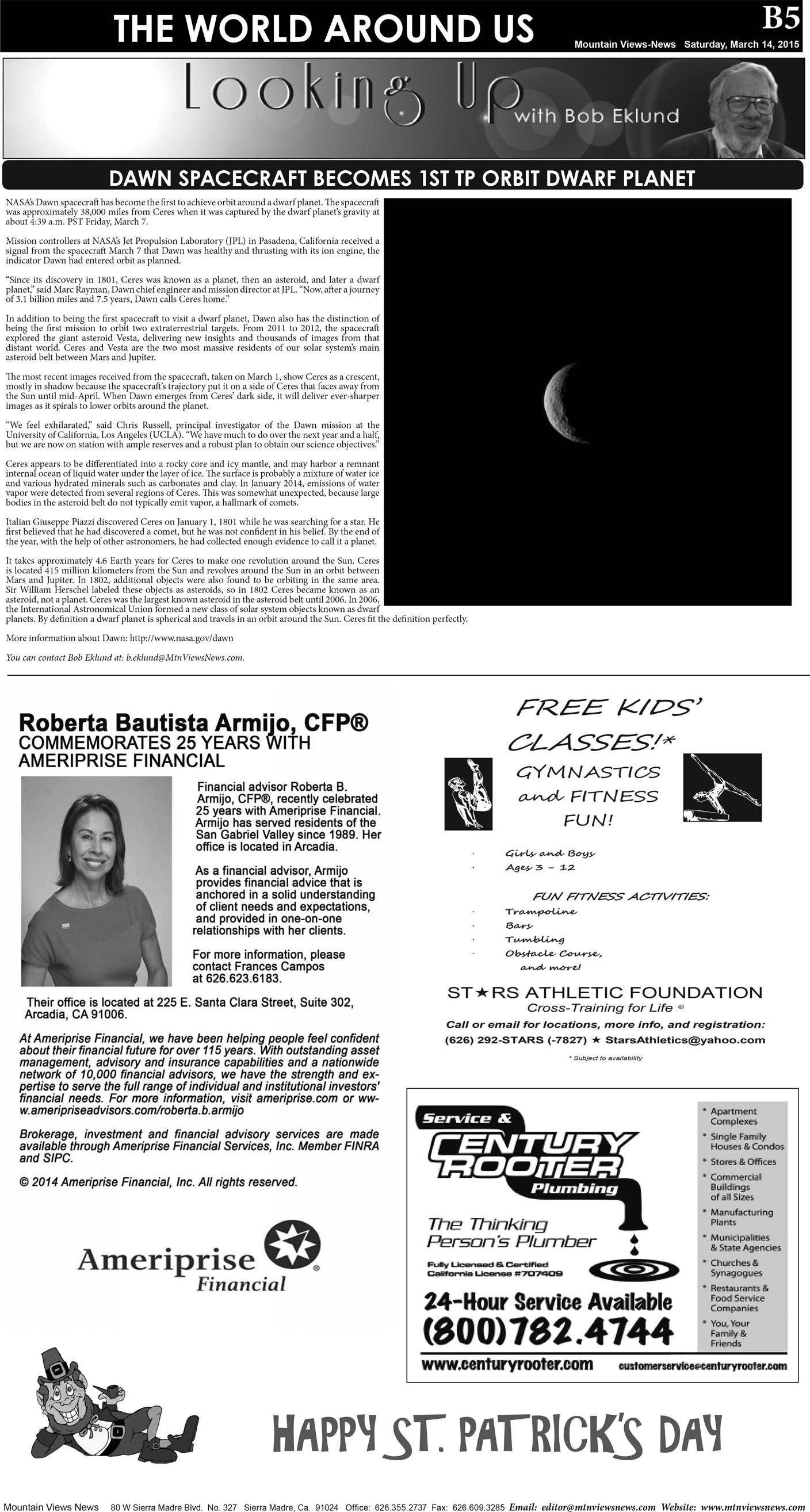|

B5
THE WORLD AROUND US
Mountain Views-News Saturday, March 14, 2015
DAWN SPACECRAFT BECOMES 1ST TP ORBIT DWARF PLANET
NASA’s Dawn spacecraft has become the first to achieve orbit around a dwarf planet. The spacecraft
was approximately 38,000 miles from Ceres when it was captured by the dwarf planet’s gravity at
about 4:39 a.m. PST Friday, March 7.
Mission controllers at NASA’s Jet Propulsion Laboratory (JPL) in Pasadena, California received a
signal from the spacecraft March 7 that Dawn was healthy and thrusting with its ion engine, the
indicator Dawn had entered orbit as planned.
“Since its discovery in 1801, Ceres was known as a planet, then an asteroid, and later a dwarf
planet,” said Marc Rayman, Dawn chief engineer and mission director at JPL. “Now, after a journey
of 3.1 billion miles and 7.5 years, Dawn calls Ceres home.”
In addition to being the first spacecraft to visit a dwarf planet, Dawn also has the distinction of
being the first mission to orbit two extraterrestrial targets. From 2011 to 2012, the spacecraft
explored the giant asteroid Vesta, delivering new insights and thousands of images from that
distant world. Ceres and Vesta are the two most massive residents of our solar system’s main
asteroid belt between Mars and Jupiter.
The most recent images received from the spacecraft, taken on March 1, show Ceres as a crescent,
mostly in shadow because the spacecraft’s trajectory put it on a side of Ceres that faces away from
the Sun until mid-April. When Dawn emerges from Ceres’ dark side, it will deliver ever-sharper
images as it spirals to lower orbits around the planet.
“We feel exhilarated,” said Chris Russell, principal investigator of the Dawn mission at the
University of California, Los Angeles (UCLA). “We have much to do over the next year and a half,
but we are now on station with ample reserves and a robust plan to obtain our science objectives.”
Ceres appears to be differentiated into a rocky core and icy mantle, and may harbor a remnant
internal ocean of liquid water under the layer of ice. The surface is probably a mixture of water ice
and various hydrated minerals such as carbonates and clay. In January 2014, emissions of water
vapor were detected from several regions of Ceres. This was somewhat unexpected, because large
bodies in the asteroid belt do not typically emit vapor, a hallmark of comets.
Italian Giuseppe Piazzi discovered Ceres on January 1, 1801 while he was searching for a star. He
first believed that he had discovered a comet, but he was not confident in his belief. By the end of
the year, with the help of other astronomers, he had collected enough evidence to call it a planet.
It takes approximately 4.6 Earth years for Ceres to make one revolution around the Sun. Ceres
is located 415 million kilometers from the Sun and revolves around the Sun in an orbit between
Mars and Jupiter. In 1802, additional objects were also found to be orbiting in the same area.
Sir William Herschel labeled these objects as asteroids, so in 1802 Ceres became known as an
asteroid, not a planet. Ceres was the largest known asteroid in the asteroid belt until 2006. In 2006,
the International Astronomical Union formed a new class of solar system objects known as dwarf
planets. By definition a dwarf planet is spherical and travels in an orbit around the Sun. Ceres fit the definition perfectly.
More information about Dawn: http://www.nasa.gov/dawn
You can contact Bob Eklund at: b.eklund@MtnViewsNews.com.
HAPPY ST. PATRICK’S DAY
|